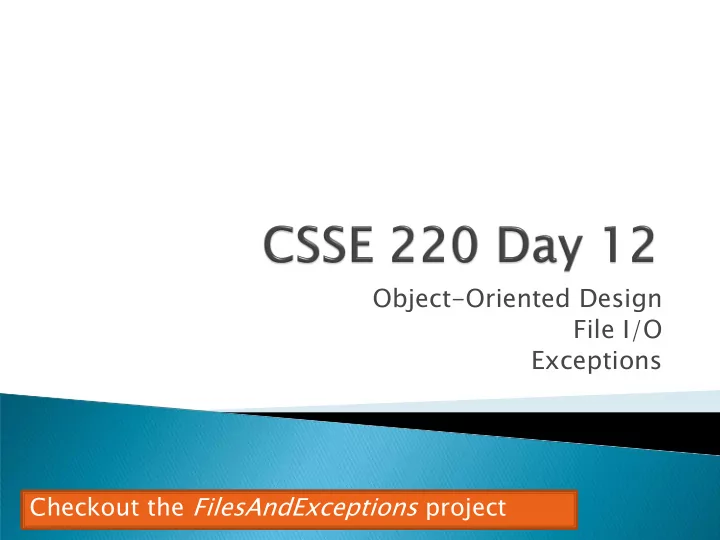

Object-Oriented Design File I/O Exceptions Checkout the FilesAndExceptions project
Please complete the Project Team Preference Survey
LayoutManagers for Java GUIs BallWorlds work time
Classes usually are related to their collaborators Draw a UML class diagram showing how Common relationships: ◦ Inhe Inheritance: only when subclass is a s a special case ◦ Aggreg egat ation: when one class ha has a a field ld that references another class NEW! ◦ Depend ndenc ncy: like aggregation but transient, usually for method parameters, “has a a” tempora raril rily ◦ Assoc ociat ation on: any other relationship, can label the arrow, e.g., constr tructs ts
Q1
Draw UML class diagrams based on your CRC cards Initially just show classes (not insides of each) Add insides for two classes
When JFrame’s and JPanel’s defaults just don’t cut it.
Answer: 5 We use the two-argument version of add : JPanel p = new JPanel(); frame.add(p, BorderLayout.SOUTH); JFrame ’s default LayoutManager is a BorderLayout LayoutManager instances tell the Java library how to arrange components BorderLayout uses up to five components Q2
Answer: arbitrarily many Additional components are added in a line JPanel ’s default LayoutManager is a FlowLayout
We can set the layout manager of a JPanel manually if we don’t like the default: JPanel panel = new JPanel(); panel.setLayout(new GridLayout(4,3)); panel.add(new JButton("1")); panel.add(new JButton("2")); panel.add(new JButton("3")); panel.add(new JButton("4")); // ... panel.add(new JButton("0")); panel.add(new JButton("#")); frame.add(panel);
A LayoutManager determines how components are laid out within a container • BorderLayout . When adding a component, you specify center, north, south, east, or west for its location. (Default for a JFrame.) • FlowLayout : Components are placed left to right. When a row is filled, start a new one. (Default for a JPanel.) • GridLayout . All components same size, placed into a 2D grid. • Many others are available, including BoxLayout , CardLayout , GridBagLayout , GroupLayout • If you use null for the LayoutManager , then you must specify every location using coordinates More control, but it doesn’t resize automatically Q3
Chapter 18 of Big Java Swing Tutorial ◦ http://docs.oracle.com/javase/tutorial/ui/index.ht ml ◦ Also linked from schedule
Reading & writing files When the unexpected happens
Look at GameOfLifeWithIO ◦ GameOfLife constructor has 2 listeners, two local anonymous class ◦ ButtonPanel constructor has 3 listeners which are local anonymous classes Feel free to use as examples for your project
Input: File and Scanner Output: PrintWriter and println Be kind to your OS: close() all files Letting users choose: JFileChooser and File Expect the unexpected: Exception handling Refer to examples when you need to… Q4-Q6
Used to signal that something went wrong: ◦ throw new EOFException(“Missing column”); Can be cau aught by ex excep ception h han andler ◦ Recovers from error ◦ Or exits gracefully Q7
Java has two sorts of exceptions Chec ecke ked ex excep ceptions: compiler checks that calling code isn’t ignoring the problem ◦ Used for expec ected ed problems Unchecked d except ptions: compiler lets us ignore these if we want ◦ Used for fatal al or avoidab able problems ◦ Are subclasses of RunTimeException or Error Q8-Q9
Dealing with checked exceptions ◦ Can propag agat ate the exception Just declare that our method will pass any exceptions along public void loadGameState() throws IOException Used when our code isn’t able to rectify the problem ◦ Can handle le the exception Used when our code can rectify the problem Q10
Use try-catch statement: ◦ try { // potentially “exceptional” code Can repeat this } catch ( ExceptionType var ) { part for as many // handle exception different } exception types as Related, try-finally for clean up: you need. ◦ try { // code that requires “clean up” } finally { // runs even if exception occurred }
Demonstrate the program
A team assignment ◦ So som some di division of of l labor is a s app ppropriate (indeed, necessary) A learning experience, so: ◦ Rule 1: ev ever ery team member m mus ust p participate i in n ev ever ery major a r activit ity. . E.g., you are not allowed to have someone do graphics but no coding, ◦ Rule 2: Everyth thing t g that y t you s subm bmit f t for t this proj oject t shou ould b d be u unde dersto tood d by all ll tea eam m member ers. Not necessarily all the details, but all the basic ideas
Read the specification if you haven't done so Start working on your milestone 0 due due ne next clas ass ◦ Try to get it done in class today so you can: Get some feedback in class before it’s graded.
There are milestones due most class days: For next class: ◦ User stories ◦ CRC cards ◦ UML class diagram ◦ See the project description for details ◦ Suggestion: Plan to implement a considerable amount of functionality in Cycle 1 It is the longest cycle that you will have
BallWorlds Q11-Q12
Recommend
More recommend